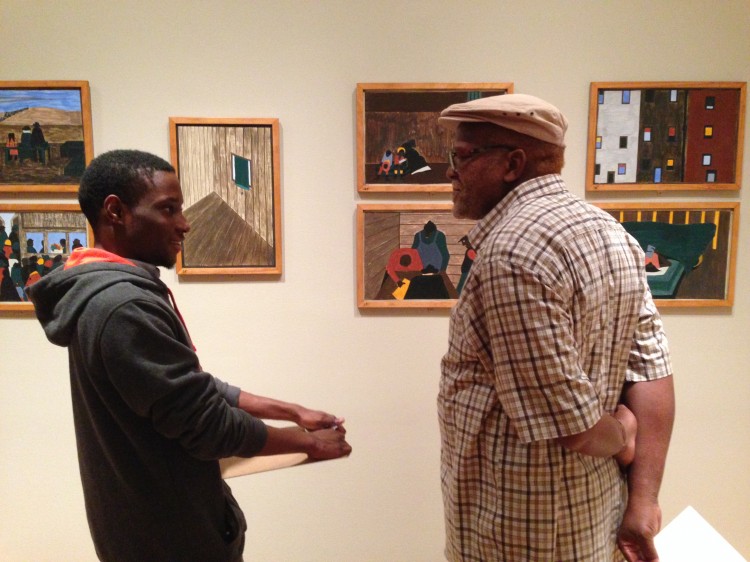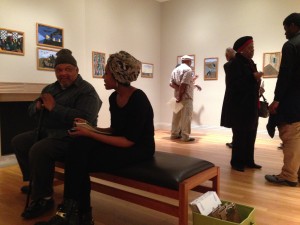Cosby Hunt, Manager of Teaching and Learning at Center for Inspired Teaching in Washington, DC, recently brought his Real World History class to the Phillips to explore Jacob Lawrence’s The Migration Series. Here he reflects on this experience and other memories related Jacob Lawrence.

A student asks an elder about his life while looking at The Migration Series. Photo: Andrea Kim Taylor
I came home the summer after my first two years of teaching and cut all my hair off. It was 1995, and I had just spent the last two years getting my butt kicked as a new teacher in rural Georgia. I had told Teach for America in 1993 that I would teach “anywhere” as long as I could teach secondary social studies, and they sent me anywhere: Sparta, Georgia. I wouldn’t trade those two years for the world; that time was the beginning of my career as an educator.
My mother took a photo of my hair just before the haircut: close on the side and dreadlocks on top lying back—probably having been just released from whatever bandanna was holding them in place. Later that day I came home from the barber with a closely shaved head, the locks I’d spent three years cultivating swept off the floor of the barber shop by the time I put my key in the ignition to return home. A week or so later my mother took me and my newly shaved head to see the artist Jacob Lawrence speak at the University of Akron. That was the last substantial thing I remember doing with her; she died soon thereafter in August 1995.
I have been teaching students and teachers in Washington, DC, the town where my mother and father raised me, since 1997. Recently I was able to reconvene with Mr. Lawrence—at least in spirit—when I took a group of high school students to The Phillips Collection to view his epic Migration Series. My students were working on oral history projects as part of our Real World History Class—an after school honors elective class in which 20 students from ten different high schools across the city are enrolled. We spent the fall reading Isabel Wilkerson’s The Warmth of Other Suns: The Epic Story of America’s Great Migration. In keeping with the ideals of the class and Center for Inspired Teaching, it was time to shift from (just) studying history to actually doing it. I paired the students with black Washingtonians who moved here from the South before 1970 and arranged for these older adults to meet us at the Phillips so that they and the students could view the series together. After students viewed the series with their interviewees, all of them sat together, discussed, and recorded what they had seen in the gallery.
It was a delight seeing the teenagers switch into respect-for-their-elders mode; watching young and old discuss artwork and history together was a treat. I’m certain that Lawrence’s work sparked some questions from the students that they wouldn’t have otherwise asked. For example, Panel no. 53 in the series features long-time African-American residents of northern cities who met the migrants with “aloofness and disdain,” which prompted one student to ask her interviewee if she had encountered similar disdain. Another student made connections between some of the brutality shown in the Lawrence’s work with the recent events in Ferguson, Missouri and Staten Island, New York.
I can’t wait to read the oral history projects the students have just submitted, and I’m already looking forward to the time I’ll spend with Lawrence’s The Migration Series and next year’s Real World History students.
Cosby Hunt, Manager of Teaching and Learning at Center for Inspired Teaching


